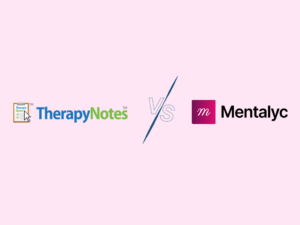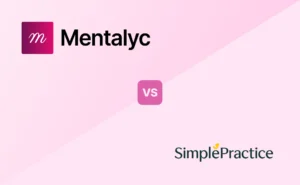Are you ready to take your therapy game to the next level? Get excited about the PCL-5, a powerful assessment tool that will revolutionize how you identify potential posttraumatic stress disorder (PTSD) in your clients. With a simple and quick process, you can gain valuable insight into your client’s symptoms and how they compare to the DSM-5 criteria for PTSD.
Plus, it’s completely free! This checklist is perfect for your intake process, providing critical information in under an hour. Worried about how to begin using the PCL-5 or interpret the results? Fear not! Our comprehensive guide has got you covered. We’ll teach you everything you need to know about this game-changing tool, from how to administer and score the test to answering common questions about the assessment. Get ready to transform your practice and help your clients like never before!
What is the PCL-5, and Why is it Used?
The PTSD Checklist for DSM-5, commonly known as the PCL-5, is a self-report rating scale for assessing PTSD symptoms. Initially developed in 1993, it has been updated to align with the DSM-5 diagnostic criteria for PTSD. Both military and civilian populations widely use the PCL-5 to evaluate the severity of PTSD symptoms quickly. With just 20 questions, this assessment tool provides valuable insights into how PTSD affects an individual’s life and relationships.
Moreover, therapists can use it to monitor progress throughout the treatment process. This information is crucial for clinicians to understand how PTSD impacts clients and develop customized treatment plans that address their needs. The PCL-5 is a widely trusted tool that provides practitioners with the necessary information to deliver appropriate care. By comprehending each client’s unique experiences, practitioners can design focused treatment plans tailored to their specific situation.

New! Transfer your notes to EHR with a single click. No more copy-pasting.
How Does the PCL-5 Work?
The PCL-5 questionnaire is a valuable tool for assessing symptoms related to PTSD within the past month. It comprises 20 items, each rated on a scale from 0 to 4, indicating the severity of the symptoms. The rating scale ranges from 0, which means “not at all,” to 4, which means “extremely.” Mental health practitioners can determine the total score obtained by adding the numerical responses to all 20 items. Scores range from 0 to 80; a higher score indicates more severe symptoms. A score of 33 or above may suggest a possible PTSD diagnosis, and clients with lower scores may require further evaluation to ensure an accurate diagnosis.
However, it’s essential to note that the PCL-5 questionnaire is not the sole diagnostic tool but should be part of a comprehensive assessment. Therefore, healthcare professionals should use it with other diagnostic tools to provide the best possible care to their clients.
The Limitations of the PCL-5
When using the PCL-5 checklist, it’s important to understand its limitations. By interpreting the results correctly and recognizing these limitations, you can effectively screen for symptoms of PTSD and determine the appropriate steps for diagnosis and treatment.
One major limitation of the PCL-5 is that it relies on self-reported symptoms, which can be affected by factors like downplaying or exaggerating symptoms. Additionally, the PCL-5 requires a minimum reading level of 6th grade, which may only be suitable for some clients.
Some additional limitations to be aware of:
- Cultural, educational, and socioeconomic differences can affect how people interpret and respond to the questions.
- The PCL-5 measures current symptom severity, so it may miss symptoms that fluctuate or change over time.
- The cut-point of 33 is just a preliminary guideline. Clinicians should use their judgment based on individual patients and the assessment context.
- The PCL-5 can’t determine the complexity of symptoms or if there are co-occurring conditions.
Prerequisites for Administering the PCL-5
To properly administer the PCL-5, you’ll need to meet a few prerequisites:
- You must be a licensed mental health professional trained in assessing and diagnosing PTSD. The PCL-5 is a clinical tool not meant for self-assessment or casual use.
- Obtain informed consent from the patient before administering the PCL-5. Explain that it’s used to determine if they meet the criteria for a PTSD diagnosis, that their responses will be kept confidential, and that they can stop at any time.
- Choose between the PCL-5 Standard or PCL-5-Specific Version. The Standard Version asks about any traumatic event, while the Specific Version focuses on a single identified traumatic event. Use the version most relevant for your patient.
Once these prerequisites are met, find a quiet space free of distractions to conduct the PCL-5 interview. If needed, read each of the 20 questions aloud, one by one, and record the patient’s responses. Clarify any questions they may have to ensure the most accurate answers.
Administering and Scoring the PCL-5
To properly administer and score the PCL-5, there are a few key steps to keep in mind:
Gather Materials
You’ll need copies of the PCL-5 questionnaire, pens or pencils, a scoring sheet, and a digital or physical timer.
Explain Instructions
Inform the client that they may be asked about any stressful experiences they have had. Clarify that there are no correct or incorrect answers, and their answers will aid in determining if they are experiencing symptoms of PTSD.
Set Time Limit
For the self-administered version, set a timer for 10-15 minutes. This provides enough time to consider each item without feeling rushed thoughtfully. For interviewer-administered versions, there is no time limit, but the entire PCL should take around 10-15 minutes for most clients.
Have your Client Complete the Questionnaire
Ask the client to complete the 20-item self-report measure by rating how much they have been bothered by each problem in the past month.
Score Responses
Add up the scores for all 20 items to get a total severity score. Scores of 33 or higher indicate possible PTSD. Then, look at individual item scores – items rated as “Moderately” or higher (3 or 4) may indicate areas of particular concern.
Interpret Results
It’s important to understand that while higher scores on the PCL-5 may indicate a higher chance of PTSD, it is not meant to be the only diagnostic tool. Only a licensed professional is authorized to make an official PTSD diagnosis. The PCL-5 is designed to help with assessment and screening, and it has proven to be effective in monitoring treatment progress and screening for PTSD.
However, it should be used with other assessment tools and clinical judgment, and it cannot replace a comprehensive diagnostic evaluation. The PCL-5 can offer valuable information to support diagnosis and guide treatment planning when administered and scored correctly.
Tips for Using PCL-5 Effectively in Your Practice
With the right approach, you can make the PCL-5 an indispensable tool for assessing PTSD in your practice. Following these guidelines will help you achieve accurate and reliable results and ensure your clients receive the necessary care.
Thorough Understanding
To utilize PCL-5 to its full potential, it is essential to have a comprehensive understanding of the tool. Before administering the checklist, familiarize yourself with the different items on the list and the scoring system. The more you know about PCL-5, the better you can interpret the results and suggest suitable treatment recommendations.
The first step to effectively using the PCL-5 is thoroughly understanding the tool. Before administering the checklist, be sure you’ve familiarized yourself with the various items on the list and the scoring system. The more you know about the PCL-5, the better equipped you’ll be to interpret the results and provide appropriate treatment recommendations.
Optimal Timing
When administering the PCL-5 to clients, it is crucial to choose a time when they are not experiencing acute distress. High-stress levels can affect the results, so it’s best to conduct the test during a stable period; this will allow for an accurate evaluation of the patient’s symptoms over the past month.
Open Communication
It is crucial to have open communication with your patient. Ensure that they comprehend the purpose of the PCL-5 and how it can aid in their treatment. Show patience and sensitivity towards their responses. Allow them to ask questions and voice any worries; this will help them feel at ease and more inclined to provide honest and precise answers.
Scoring and Interpretation
It is important to score and interpret the PCL-5 accurately. Make sure to check your calculations and interpretations carefully. Keep a reference guide nearby for quick reference if needed. Remember that the PCL-5 is a self-report measure that relies on the patient’s honesty and understanding. Be mindful of any potential biases or distortions.
Integration with Other Measures
The PCL-5 is a valuable tool for diagnosis and should be used in conjunction with other assessments such as questionnaires, clinical interviews, and observational data. Integrating the findings from multiple sources can provide a complete understanding of the client’s condition.
PCL-5 FAQs and Example Questions
How is the PCL-5 administered and scored?
The PCL-5 can be self-administered or interviewer-administered. Respondents rate each item on a 5-point scale ranging from 0 (“Not at all”) to 4 (“Extremely”) based on the past month. Total scores range from 0 to 80. Higher scores indicate greater severity of PTSD symptoms. There are suggested cutoff scores for a provisional PTSD diagnosis, ranging from 30-38 or higher. However, the PCL-5 should not be used as a standalone diagnosis. Instead, the PCL-5 should be used in conjunction with a clinical assessment.
Who can administer the PCL-5?
Qualified mental health professionals.
How long does it take to complete?
Around 5-10 minutes.
How often should the PCL-5 be re-administered?
It can be used to monitor changes during and after treatment. Re-administer as often as needed based on your clinical judgment.
What are some limitations of the PCL-5?
Some fundamental limitations include:
- It relies on self-reporting, so factors like social desirability can influence scores.
- It does not assess trauma exposure or other life events.
- It does not determine causality or differentiate between PTSD and other disorders.
- There may be differences based on gender, ethnicity, and age.
PCL-5 Example Questions:
- Do you experience repeated, disturbing memories, thoughts, or images of a stressful experience?
2. Do you feel very upset when something reminds you of a distressing event?
3. Are you avoiding memories, thoughts, or feelings related to the traumatic incident?
Assessing PTSD in patients can be done effectively with the help of the PCL-5 tool. However, it’s essential to use it correctly. To make the most of this diagnostic tool, it’s necessary to understand it well, communicate openly, score accurately, and integrate it with other measures. Using the PCL-5 in your practice will provide valuable insights and enable better treatment planning for your clients.
One of the best ways to improve your mental health knowledge and skills is by subscribing to Mentalyc’s newsletter. Our resources are designed to assist clinicians in better understanding mental health and serving their clients. In addition to saving time on progress notes, our AI-powered tool is a fantastic option for those interested in maximizing their productivity! We’re here to help at every step – so register now to begin making a positive impact!
Disclaimer
All examples of mental health documentation are fictional and for informational purposes only.
Why other mental health professionals love Mentalyc

“A lot of my clients love the functionality where I can send them a summary of what we addressed during the session, and they find it very helpful and enlightening.”
Therapist

“Having Mentalyc take away some of the work from me has allowed me to be more present when I’m in session with clients … it took a lot of pressure off.”
LPC

“It takes me less than 5 minutes to complete notes … it’s a huge time saver, a huge stress reliever.”
Licensed Marriage and Family Therapist

“By the end of the day, usually by the end of the session, I have my documentation done. I have a thorough, comprehensive note … It’s just saving me hours every week.”
CDCII






